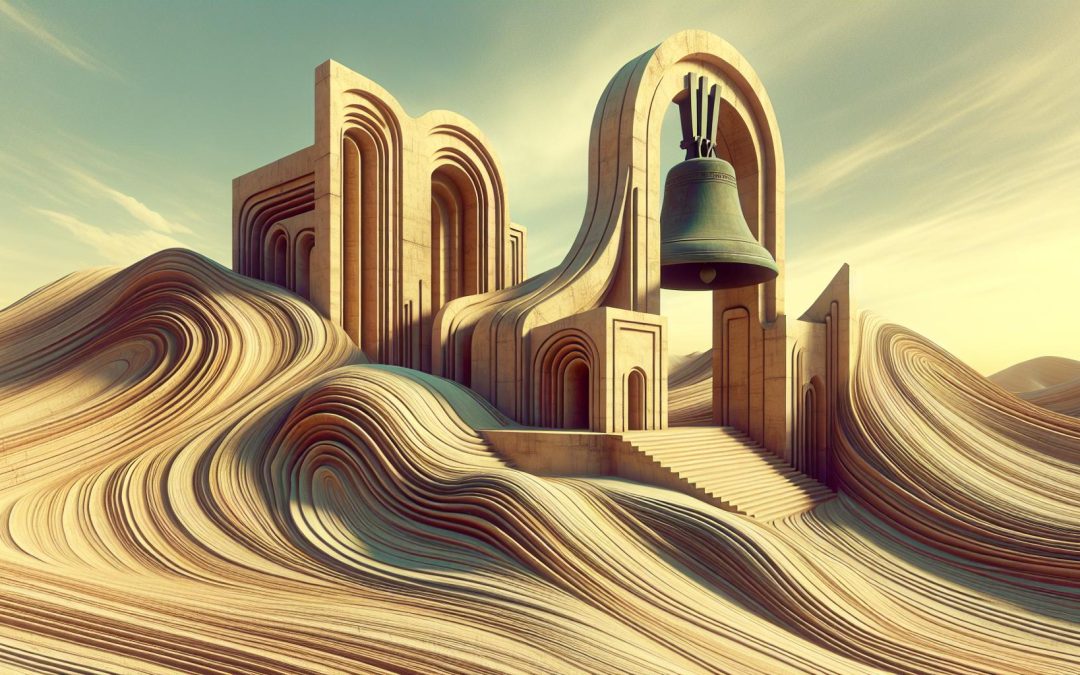Nestled in the heart of Paradise Valley, Arizona, Cosanti isn’t just a place; it’s an experience. This architectural wonder, created by the visionary architect Paolo Soleri, blends art, architecture, and ecology in ways that defy traditional boundaries. It’s not every day you come across a place that’s both a workshop for exquisite bronze bells and a landmark of innovative design.
Walking into Cosanti, I felt like I’d stepped into a world where creativity knows no bounds. The blend of earthy structures with the melodious backdrop of bronze bells creates an atmosphere that’s both tranquil and stimulating. It’s a hidden gem that offers a unique glimpse into Soleri’s philosophy of ‘arcology’ – architecture coexisting harmoniously with ecology.
The Visionary Architect – Paolo Soleri
As I ventured deeper into understanding Cosanti, the name Paolo Soleri became not just a reference but a beacon of inspiration. Born in Turin, Italy, in 1919, Soleri’s journey from an architecture student in Italy to a visionary architect in Arizona is a story of relentless pursuit and profound creativity. His philosophy, arcology, which blends architecture and ecology, was not just a concept but a call to revolutionize how we interact with our environment.
Soleri’s approach to architecture was radical. He believed in creating spaces that did more than serve as shelter; they were to be living, breathing systems that were self-sustaining. This vision led him to build Cosanti. Here, he experimented with earth-casting techniques and innovative designs that minimized ecological impact while maximizing functional and aesthetic value.
My exploration of Soleri’s work revealed a man deeply concerned with the future of urban planning. He foresaw the challenges of urban sprawl and proposed alternatives that emphasized verticality and density over horizontal expansion. Soleri aimed for a harmonious balance between humanity and the Earth, aspiring to create communities that were self-sufficient and in tune with nature’s principles.
Delving into Soleri’s philosophy, I realized the depth of his foresight. His designs weren’t just blueprints; they were a roadmap towards a more sustainable and interconnected world. At Cosanti, every arch, every bell, speaks to Soleri’s commitment to a world where architecture serves not just humanity but the planet’s wellbeing.
Through his workshops, writings, and the legacy of Cosanti, Paolo Soleri has left an indelible mark on architectural thought. His work challenges us to think differently about the spaces we inhabit and the footprint we leave on the Earth. Cosanti stands as a testament to Soleri’s innovative spirit, inviting all who visit to ponder the possibilities of a future built on harmony between our creations and the environment.
The Unique Blend of Art, Architecture, and Ecology

As I dive deeper into the heart of Cosanti, it’s clear that Paolo Soleri’s vision was not just about constructing buildings but creating a symphony of art, architecture, and ecology. Walking through the premises, it’s as if every corner, every structure, speaks of a harmony that exists between human creativity and the natural world.
Soleri’s concept of arcology is vividly alive here, where buildings aren’t mere shelters but are integrated into the landscape, enhancing rather than disrupting the environment. Cosanti is a living example of how spaces can function both as artistic expressions and vital components of the ecosystem. The use of local materials, natural light, and the unique passive cooling systems are testaments to an architectural philosophy that prioritizes sustainability without sacrificing beauty.
At the heart of Cosanti, the bronze bell foundry captures the essence of this blend perfectly. The process of crafting these bells involves a harmonious balance of human skill and fire’s elemental force, resulting in creations that are not only melodious but also embody the fusion of art and ecology. Each bell is a piece of Soleri’s legacy, encouraging us to rethink our relationship with our surroundings.
Through workshops and tours, I’ve gained insights into how Soleri’s principles are imparted to others, fostering a community that values creativity, sustainability, and connectivity. Witnessing the creation of bronze bells, exploring the earth-cast structures, and hearing the stories behind this magical place, I’m reminded that Cosanti is more than just an architectural landmark; it’s a vibrant dialogue between humanity and nature.
As Soleri once imagined, places like Cosanti challenge us to envision a world where architecture transcends its traditional boundaries, serving as a bridge towards a more sustainable and integrated future. The legacy of Cosanti, therefore, isn’t just in its buildings or bells but in its ongoing conversation with the world, inviting us all to partake in this visionary blend of art, architecture, and ecology.
A Workshop of Exquisite Bronze Bells
As I stepped into the realm of the bronze bell workshops at Cosanti, the air was filled with a symphony of sound and creativity. These workshops aren’t just spaces where bells are made; they’re studios where art and craftsmanship blend seamlessly.
The process of making these bells is as fascinating as the finished products themselves. Each bell is crafted through the ancient art of bronze casting, a technique that has been employed for centuries but is given a unique twist here. The craftsmen at Cosanti use molds made from sand, a process that ensures no two bells are exactly alike. This uniqueness is what makes the bells not just tools for sound but pieces of art.
The Significance of the Bells
The bells carry more than just aesthetic value; they are a testament to Soleri’s philosophy of integrating art, architecture, and ecology. They reflect his vision of creating beautiful yet functional artefacts that harmonize with their environment. Each purchase of a Cosanti bell supports the ongoing projects and research at Cosanti, making buyers participants in this visionary endeavor.
The Range of Designs
From the delicate wind chimes to the robust garden bells, the variety is astounding. I found myself drawn to the intricate patterns and rich patinas that give each bell its character. The bells come in various sizes and designs, each carrying a distinct sound that adds a layer of beauty to any space it occupies. Here are some of the types I observed:
- Wind Bells: Ideal for hanging in gardens or patios to catch the breeze.
- Garden Bells: Larger, designed to stand as focal points in outdoor spaces.
- Sculptural Bells: These are as much sculptures as they are bells, meant to adorn living spaces.
The workshops at Cosanti don’t just produce bells; they’re keeping alive a tradition that merges artistry with the principles of sustainable living. Witnessing the crafting process and hearing the stories behind each bell, I realized that these aren’t mere objects. They’re pieces of a larger narrative, one that speaks to rethinking how we live and interact with our surroundings.
Exploring the Architectural Wonders of Cosanti
When I first stepped into Cosanti, it wasn’t just the allure of the bronze bells that took my breath away but the captivating architecture sprawling across the landscape. Designed by the visionary Paolo Soleri, Cosanti stands as a testament to Soleri’s principles of Arcology – a portmanteau of architecture and ecology. This concept reimagines the way we inhabit and interact with our environment, a philosophy deeply embedded in every structure and space within Cosanti.
As I wandered through the compound, the Earth-Cast Concrete Structures immediately captured my imagination. Soleri’s technique involves casting concrete against the earth, resulting in organic forms that seem to emerge from the ground itself. These buildings, with their intricate textures and earthy tones, blend seamlessly with the Arizona desert. It feels like they’re part of the landscape, born from the soil and returning to it.
Among these structures, the open-air studios where the famous bronze bells are crafted are particularly striking. Here, art and architecture converge, offering a glimpse into a world where form meets function in the most beautiful way. The amphitheater, used for gatherings and performances, showcases Soleri’s skill in creating spaces that are not only functional but also spiritually uplifting.
The Apse, a semi-dome structure, stands out with its ability to capture light and shadow in a play that changes with the time of day and season. This attention to the solar and lunar cycles is a reminder of Soleri’s dedication to living in harmony with nature.
Walking through Cosanti, it’s clear that every corner, every path, and every structure tells a story. A story of a place where architecture isn’t just about buildings, but about creating a living, breathing environment that respects and enhances our connection to the earth.
Discovering the Philosophy of ‘Arcology’ at Cosanti

As I wandered through the paths of Cosanti, I found myself immersed in the philosophy of ‘Arcology’, a term coined by Paolo Soleri himself. It’s a blend of ‘architecture’ and ‘ecology,’ aiming to create environments that respect both human needs and the earth’s ecological systems. Witnessing Soleri’s work in person, it’s evident how these principles guide every aspect of this unique space.
At the heart of Arcology is the idea that architecture should work with the environment, not against it. This concept was everywhere I looked. The buildings, molded of earth-cast concrete, rise from the ground as though they were always meant to be part of the landscape. It’s fascinating how these structures don’t just occupy space; they enhance it, blending human habitation seamlessly with nature.
Moreover, the design principles at Cosanti emphasize sustainability. The open-air studios, where the renowned bronze bells are crafted, utilize natural light and ventilation. This approach reduces the need for artificial lighting and air conditioning, minimizing the environmental footprint. It’s a testament to Soleri’s vision of creating spaces that are as functional as they are beautiful.
Learning about Arcology at Cosanti offered me a deeper understanding of how architecture can be more than just buildings. It’s about creating a harmonious blend between living spaces and the environment. Soleri’s vision at Cosanti isn’t just an architectural achievement; it’s a bold statement on how we might live more thoughtfully on our planet.
Conclusion
Visiting Cosanti has been an eye-opening experience. It’s not just about admiring the unique architecture or the mesmerizing sound of bronze bells. It’s a deeper dive into Paolo Soleri’s philosophy of Arcology—a reminder of how we can live in harmony with our environment. The principles of sustainability embedded in every corner of Cosanti challenge us to rethink our own living spaces. It’s a testament to the fact that thoughtful design can make a world of difference in our relationship with nature. So if you’re ever in Paradise Valley, I highly recommend stopping by Cosanti. It’s more than a visit; it’s an inspiration.







